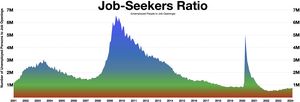| This article needs additional citations for verification. Please help improve this article by adding citations to reliable sources. Unsourced material may be challenged and removed. Find sources: "Overheating" economics – news · newspapers · books · scholar · JSTOR (April 2009) (Learn how and when to remove this message) |


Overheating of an economy occurs when its productive capacity is unable to keep pace with growing aggregate demand. It is generally characterised by an above-average rate of economic growth, where growth is occurring at an unsustainable rate. Boom periods are often characterised by overheating in the economy. An economy is said to be overheated when producers are not able to supply all the goods that consumers demand. The main reason behind overheating is insufficient supply allocation because of excess spending by the people due to increase in consumer wealth.
Causes


High levels of aggregate demand tend to be the cause of overheating. If short run aggregate demand exceeds long run aggregate supply, then the excess demand for goods must be met via the over-employment of resources. This may be achieved by employing workers for extra shifts or using machinery beyond their recommended working hours. This type of production is considered unsustainable because the over-employment cannot be supported indefinitely. Overheating can be prevented by means of constant infrastructure expansion to eliminate bottlenecks.
Effects
Overheating is generally preceded by lower than average economic growth. Demand pull inflation occurs as suppliers try to capitalize on the excess demand which cannot be met via existing production constraints. These higher prices tend to reduce aggregate demand and exports (since goods and services become more expensive abroad) leading to reduced consumption. Central banks often simultaneously tighten monetary policy in response to increased inflationary pressures, reducing investment expenditure, which in tandem with decreased consumption, can lead to economic recession.
Historical instances
- The Lawson Boom of the late 1980s/early 90s in the UK
- Switzerland during the periods of 1962–1967, 1971–1974, 1988–1991
- Imperial Iran during the Pahlavi dynasty from 1974 to 1978
See also
References
- "La surchauffe - rts.ch - archives - télévision - divers". archives. 16 January 1963. Retrieved 2011-11-04.
- "Archived copy". archives.tsr.ch. Archived from the original on 16 July 2011. Retrieved 17 January 2022.
{{cite web}}: CS1 maint: archived copy as title (link)
External links
This article related to macroeconomics is a stub. You can help Misplaced Pages by expanding it. |